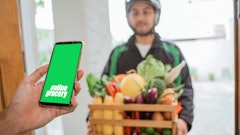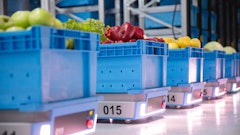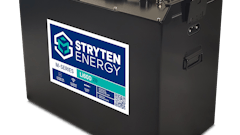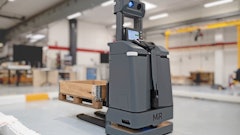
The challenges facing today’s food and beverage warehouse manager are numerous – SKU proliferation, omnichannel order fulfillment, burdensome new government reporting requirements, global trade opportunities, rising competition and more. And they can all be summarized by one overriding quest: improved efficiency that is economically justified.
In the food and beverage supply chain, retail and wholesale distributors are finding more technologies at their disposal to tackle today’s exciting challenges and opportunities. Technology providers are improving WMS capabilities, transportation management, labor management, product traceability and materials handling equipment.
Automated storage and retrieval systems continue to play a key role in making warehouses more efficient. Wholesalers are also increasingly relying on automated guided vehicles (AVGs), augmented by RFID and optical scanning, voice technology and pick-to-light picking systems.
Changing Dynamics: Regulatory Compliance And Omnichannel Fulfillment
Automation becomes more beneficial as a warehouse operation gets more complicated, notes Norman Leonhardt, business development manager at Witron, a designer and implementer of logistics solutions. Automation reduces the chances for error as more processes are introduced to the warehouse. Leonhardt sees omnichannel activity improving the case for automation in more warehouses.
Proposed requirements under the Food Safety Modernization Act (FSMA) also give new urgency to scanning and picking technologies. Jay Blinderman, director of product marketing at Vocollect, the voice technology provider, says the FSMA may prevent certain types of products from being together on the same pallet. Voice technology can assist in the efficient pallet build, while also providing a retailer with a record to track and trace an order and to see how a pallet was built.
The Produce Marketing Association (PMA) created the Produce Tracking and Tracing Initiative (PTI) to make trace back investigations and recalls quicker. PTI suggests use of a standard label that includes the Global Trade Item Number (GTIN), lot number, country of origin and voice pick code, Blinderman adds. Using Vocollect’s technology enables the order selector to read two or four digits at the time the product is selected, saving time, improving accuracy and enabling the PTI goal of identifying the product and speeding product removal when needed. Many retailers already require this PTI label on inbound produce, he notes.
As material handling systems are becoming more automated, warehouse managers recognize processes need to be based on the operation’s individual needs. Hence, decision makers find they need to tap outside expertise to determine the correct level of automation. Warehouse management decision makers are turning to 3PLs, integrators, IT specialists, equipment professionals and consultants to take advantage of ever-changing technology.
Marc Wulfraat, president of MWPVL International, a supply chain consulting firm, points to the multi-shuttle, goods-to-person system as a key innovation for semi-automating order picking of less than case merchandise and for eliminating traditional storage and replenishment labor functions in a distribution center. A major benefit to the multi-shuttle system, he notes, is its flexibility; it can be scaled by adding more vertical levels, by extending aisles horizontally or by adding more aisles to the system. Hence, the system works well for companies with fast and unpredictable growth rates. This is especially useful in light of the increasing demand for omnichannel order fulfillment.
Flexibility is also important as warehouse managers hope to incorporate new efficiencies as technology evolves. The split case picking function has not been fully automated yet, Wulfraat notes. “Eventually we will replace the person who does the actual order picking at the workstation with a robot,” he says. He expects that visual recognition software combined with automated robotic arms with grasping capability will enable this within the foreseeable future.
Omnichannel fulfillment is not the only factor contributing to SKU proliferation, however. Rising export trade opportunities have contributed to it in recent years, as has the growth of niche food and beverage markets and an increase in convenience foodservice formats.
The declining cost of automation over time, in conjunction with increasing labor costs, also encourages distribution warehouses to invest in automation, notes Sean O’Farrell, market development director at Dematic Corp., the provider of automation solutions. “Our Multishuttle has created some very flexible options for companies,” he notes.
Mixed case picking expands
Mixed case picking has become critical as wholesalers address SKU proliferation. Wirtz Beverage, a Cicero, Ill.-based beverage distributor, found having 12 pick modules in a centralized warehouse invaluable for improving the speed of delivery throughout Illinois, notes Richard “Rocky” Ruane, regional director of warehouse operations.
The company found itself in a quandary when its sales doubled in 2008 to $8 million. They were shipping product from three buildings. Management, wanting to centralize its warehouse and operate more efficiently, turned to W&H Systems, an integrator, to design a facility that would allow the company to improve delivery time and take on more volume. The planning and design took about nine months and build out of the system about seven.
Ruane, a 34-year veteran at the company, says they now ship an average of 54,000 cases per night and at peak times as much as 123,000 cases, at a speed that has gained new business and helped the expand into the growing craft beer business.
W&H Systems selected Intelligrated conveyor systems and sortation units, Lucas pick-by-voice technology, and a warehouse control system (WCS) to direct inventory and operations and monitor equipment performance for Wirtz Beverage.
The blending of mixed cases and full cases on one route allows for faster delivery to more locations, notes Chris Castaldi, manager of business development at W&H Systems. “It’s all software-driven,” he says.
Food and beverage manufacturers in general are going to more layered quantities, not single-case quantities, notes Dan Labell, president of Westfalia.
Several solutions providers point to multi-shuttle systems as more time efficient
“Access to the stored goods, ranging from trays, layers to pallets, is done by means of shuttles,” notes David Blanchard, manager of applications engineering for the U.S. automated systems division at SSI Schaefer, the Germany-based logistics provider. “The requested load units are moved to lift transfer stations and buffered there. Individual access of the lifts to the transfer stations enable the sequencing of retrieval operations. Thanks to this layout, almost any number of picking and shipping stations can be configured, integrated and sequenced individually. Thus, necessary load units can be forwarded independently and in sequence to every workstation.”
Mixed load palletizing has been especially driven by the need for warehouses to ship to multiple channels, notes Mark Steinkamp, director of solutions development at Intelligrated. “You’re seeing the mixed loads more and more,” he says.
The ASRS has to build the pallet to the right weight for it to be stable, Steinkamp says. A pallet can include Coke, cereal and soup cans, but they must be in the right positions to be a stable pallet. “That’s where robots are going to be most effective,” he says. A lot of customers are interested in this as a way to get products delivered faster. Pallets can be built according to the stop.
“The (robotic) shuttle gives you very dense storage in a warehouse,” he notes These shuttles allow more to be stored in smaller spaces. For this system to work, the warehouse needs storage and picking media, sequencing media and sortation media.
Steinkamp sees the robotic shuttle becoming more prevalent in the U.S. as the big megastores become distribution centers (DCs) for smaller neighborhood stores. “We definitely are seeing a shift in the store format” to smaller stores, he notes. In this, the U.S. is following Europe.
Independent research indicates Steinkamp is correct in his assessment of retail trends. The average square footage of supermarkets in the U.S. has been falling since 2006, and is now roughly 46,000 square feet, according to the research firm, Packaged Facts. "The pendulum definitely is swinging back to smaller store formats," analysts wrote, noting that Walmart is expanding its smaller-format stores. Kroger also has a small-format store called Turkey Hill Market, which averages about 6,800 square feet, the report notes.
Omnichannel fulfillment grows
Omnichannel selling further supports this need for multi-channel order fufillment.
Supermarkets are becoming pickup destinations for Internet orders, Steinkamp notes. The DCs are becoming sites of “forward pick media” for enabling stores to become destinations for Internet orders. “It’s getting the closest product they have to the consumer,” he observes.
Centralized “pick-to-order” technology allows retailers to support smaller stores, getting them closer to their customers and making it easier of customers to get the products when they want them. Customers no longer have to plan lengthy trips to far-away supercenters. This reverses the “megastore” trend that was decimating the neighborhood grocery store in the 1980s and 1990s.
Omnichannel selling is not new. What’s happening today, observers note, is that the food and beverage industries are following the way hard goods are getting to market.
It only makes sense that a company like Amazon that has sold hard goods to multiple channels nationally has taken a pioneering role bringing food into the mix with its Amazon Fresh initiative, observers note.
Food and beverage retailers have offered home delivery on a local regional basis for years, observers further note. Ecommerce leaders like Amazon are pushing food retailers to the next level.
“We’re starting to see the dotcom come to the food world,” says Intelligrated’s Steinkamp. Hence, more food retailers are looking at it. Walmart recently announced it is testing a deport format where customers only pick up groceries ordered on Walmart’s website.
For food and beverage warehouses, omnichannel fulfillment is only in its formative stage since. Jerry Johnson, business development and marketing specialist at Knapp Logistics Automation Inc., says it’s even premature to characterize the food and beverage industry’s efforts to date as omnichannel. Johnson prefers to refer to the current efforts as “ecommerce,” which he sees as the first step to omnichannel fulfillment. “There’s a natural progression here,” he notes.
Knapp’s E-Grocer solution has been specifically designed to allow food warehouses to fulfill online orders, Johnson notes. E-Grocer is based on OSR shuttle technology.
Food retailers are using different strategies to meet ecommerce orders, Johnson says. In some instances, shoppers can pick up online orders at the supermarket. This can be problematic for some retailers, he notes. In other cases, consumers are being directed to freestanding kiosks,
Johnson points to Peapod, subsidiary of Royal Ahold that and works in partnership with Ahold USA supermarket companies Stop & Shop, Giant Food Stores (Giant-Carlisle) and Giant Food (Giant-Landover). Peapod currently has pickup sites for customers in the Northeast and in Chicago.
Automation keeps evolving
To support omnichannel order fulfillment, warehouses will continue to automate more functions.
Wirtz Beverage previously used standard methods for storage. Now the company’s Westfalia ASRS performs pallet loading storage and replenishment. The cranes can reach 10 pallets deep and drop 10 in a row. “The efficiency truly offsets the fact that they were a bit more expensive,” says Wirtz Beverage’s Ruane, who pegs the ROI at five to seven years.
The manpower savings was substantial in the new facility; the total workforce fell significantly, Ruane notes.
Voice pick technology allows them to build mixed bottles into cases automatically, which Ruane says has been 30 percent more efficient than the previous pick-to-light system. “It just keeps them (workers) focused on the job,” Ruane says. “Even when you have pick-to-light, you have time to talk to your neighbor.”
A Numina Systems camera technology photographs the cases and UPC label of every case moving along the conveyor line, capturing 1,200 cases per minute.
Ruane says the quest for efficiency doesn’t end. “We’ve got to continue looking for the next step,” he says.
AGVs play a critical role for Giant Eagle, Inc., the Pittsburgh, Pa.-based supermarket chain serving the Midwest, notes Rob Kuchta, distribution systems manager at Giant Eagle. The Seegrid AGVs, directed by the WMS, save a lot of transit time. Before the automated system, a driver had to drive pallets to a “reserve” location, then drive back to the receiving dock. With AGVs, Kuchta estimates they save 35 percent to 45 percent per pallet hauled. “Having the Seegrid AGV do the non-value added work has made the process more efficient,” he says.
Users scan the product into the WMS. The system then directs the product to the best locations based on parameters set by the WMS. The drop location for the pallet is displayed on a screen. A team member then enters each pallet’s start, drop zone and end location into the AGV’s control system with a keypad on the AGV. Once the product is delivered to the drop zone, the AGV notifies the WMS. The WMS then assigns a lift to complete the move from the drop zone to the reserve. All while the AGV returns to the dock to repeat the process.
A Dematic ASRS stores slow-moving items which are identified by the WMS in the receiving process.
Giant Eagle team members wear headsets to get voice picking instructions. They then pick to pallet jacks after confirming their location by repeating a check digit to ensure they are in the correct location.
Once pallets arrive to the shipping dock, they are manually stretched wrapped. A team member then scans the bar code, and the WMS alerts him to the proper trailer.
Henry’s Foods, an Alexandria, Minn.-based wholesaler serving five states from a 165,000-square-foot warehouse with more than 600,000 cubic feet of freezer space, improved picking accuracy and productivity by replacing its voice picking system with a wireless picking system from Procat. The system utilizes a wrist-worn Motorola touchscreen computer, a ring scanner and a mobile printer. The wireless, multi-modal device directs the worker to each pick location. The bar code scanner scans each item to verify accuracy.
After orders are picked, information is transferred from the picking server to the WMS system for invoicing.
The real time tracking of employee activity allows the Henry’s Foods to reallocate labor across work zones and functions.
Lift trucks create more options
Advances in lift truck capabilities are also creating new warehouse efficiencies.
Nature’s Best, the Brea, Calif.-based natural foods wholesaler, has rearranged its warehouse to take advantage of a Yale multi order selector, says Brian McCarthy, senior vice president of operations. The Yale Hyster MO25’s design provides the ability to slot items up to 10 feet high versus conventional equipment with a limit of 6.5 feet. In the past, McCarthy used to have a separate area in the warehouse for the slow moving SKUs. This took up extra space and required a lot of travel time.
High-velocity items can be slotted up to six feet high, while slower-moving items can be stored and picked from the same area, but at a higher position. This strategy reduces the need to travel to remote areas of the warehouse for slower-moving items.
McCarthy refers to this strategy as “variable height picking.” The taller racks allow for a smaller footprint; there isn’t as much horizontal space needed for inventory. This saves on building cost and temperature control cost while allowing the SKUs in the warehouse to grow, he notes.
McCarthy says he was able to reduce the number of pick aisles from 36 to 28, dramatically reducing the cost of racking during the construction of the warehouse. Furthermore, the variable height picking strategy reduced the number of pallet jacks from 110 to 85, allowed him to reduce the cooler and freezer size and ultimately saved the company millions of dollars of costs over the life of the warehouse design.
“In a greenfield site, I can operate a large SKU selection within a much smaller footprint utilizing this system and/or rack ‘up’ to allow room for future growth,” McCarthy says. “This methodology, when compared to conventional picking, is more than 10 percent more efficient within the four walls. There have been scores of tours within the Nature’s Best facilities and almost 75 percent of them end up moving into this model. It is a way to improve within the warehouse environment by leveraging an asset that is often underutilized; the pallet jack.”
What’s Ahead: Real-Time Data Advances
Real-time information will play a bigger role in making warehouse operations more efficient, WMS providers agree.
The WCS Plus from Retrotech offers real-time inventory visibility, coupled with real-time order fulfillment visibility, notes Tom O’Dette, regional engineering director. The system has the ability to receive raw order data from the WMS and create waves, batches, pick commands, order consolidation, shipping, inventory management, replenishment cycles, machine communication and machine control, and it controls voice-, screen-, and light-directed picking. The solution supplements the WMS, he says, allowing retailers one more tool to be successful at omnichannel fulfillment and creating a seamless customer sales experience. The system can help companies efficiently deal with SKU proliferation.
Real time data brings a new level of management to food warehouses, notes Vishal Minocha, Sr., gobal product manager at Infor, the New York, N.Y.-based business application software provider. The new SCE 10.3 includes WMS, labor management, transportation logistics and 3PL billing. Minocha says the business intelligence includes 50 new metrics, plus the ability to tweak metrics. These metrics are critical as omnichannel selling complicates order fulfillment operations. “What is a fast moving item today could be slow moving tomorrow,” he says.
The user can access real time, color-coded graphics, zoom capability and velocity heat maps. A warehouse manager can go to their dashboard screen and see where lift trucks are congested in a certain area.
Will omnichannel push collaborative distribution?
Some observers think the omnichannel growth will strengthen the case for “collaborative distribution,” by which companies share warehouse and delivery operations. This collaboration allows manufacturers and retailers to streamline processes and reduce complexity. One of the best known examples is ES3, a fully-automated grocery warehouse located in York, Pa. This 1.5 million square foot building holds 400,000 pallet positions, over 60 manufacturer partners, and stands 110 feet tall. Using technology designed by SSI Schaefer, ES3 builds fully optimized truckloads of multi-manufacturers’ product which gets delivered in less than 24 hours from the time the order is received.
ES3 has been in operation since 2002 and hopes to expand its collaboration efforts to the Southeast, and eventually Mid-West, and West Coast, notes Brenda Hambleton, chief marketing and strategy officer.
Collaborative distribution requires companies to be willing to give up control of critical functions and to also trust their data won’t be compromised.
Alex Stark, director of marketing at Kane is Able, the Taylor, Pa.-based 3PL, thinks 30 to 40 percent of the distribution cost can be eliminated through collaborative distribution. Stark recognizes that getting companies to cooperate is hard; many resist doing this because it goes against convention. But he notes that because of rising transportation costs, shippers are raising their rates as well as minimum freight requirements.
Omnichannel Initiatives To Continue
In the near term, more retailers will be expanding omnichannel sales initiatives. Many observers are keeping a close eye on Amazon Fresh, which expanded from Seattle, Wash. to California in 2013. This year, the company confirmed plans to expand to as many as 20 new geographic markets.
One of the key advantages Amazon Fresh brings to the table, observers note, is that shoppers can order non-food consumer goods in addition to food, such as gifts along with food orders. In 2012, Amazon acquired Kiva Systems, a manufacturer of robotic technology, and announced plans to install 10,000 robotic systems in its fulfillment centers.
Google entered the fray last year with Google Shopping Express, and this year it expanded the service in certain markets to include overnight delivery, bringing online shoppers who browse the Web in the evening hours their Target, Whole Foods, Walgreens, Office Depot and Staples.
As ecommerce leaders such as Amazon, Google, eBay and others bring competitive pressure to food and beverage retailers, the retailers will respond with ecommerce initiatives of their own. Retailers will look to wholesale partners and logistics services providers to improve their omnichannel fulfillment capabilities.





























